
Alive and Well After
All These Years
What's new here at the PSLC and the Macrogalleria?
Lots, so let me tell you about it...
This page will tell you about recent work accomplished or underway at the PSLC.
You can click on any of the images below to go directly to that segment OR
you can get back to the main index page by clicking here.
You can click on any of the images below to go directly to that segment OR
you can get back to the main index page by clicking here.
First a little background music (as they used to say on the Lawrence Welk Show, I think)... Advances in polymer science continue in our world, providing us with new knowledge, understanding and applications that expand at an increasing rate. We know more than ever about polymers, but like most science disciplines, there's always need for the basics presented in clear, concise language.
As new generations seek knowledge about science in general and polymers specifically, this need for education in the basics of polymers is expanding also. There are a variety of efforts to include polymer topics and courses in high school and undergraduate curricula, which is valuable, but these have met with limited success over the years. Thus, there is an increasing need for web-based polymer education to complement and support this effort.
Most important is the increasing demand for supplemental polymer information in multimedia format to assist a broad range of practicing professionals in understanding the materials they deal with. Doctors, dentists, medical practitioners, lawyers and judges in patent disputes, engineers of all stripes, and K-12 teachers have need of such informal polymer information.
The utility of the Polymer Science Learning Center is confirmed by a "Webalyzer" analysis of usage of the www.pslc.ws pages, with an average of 8,000 visitors per day, every day. Efforts to update and expand the site continue as outlined below.
Where it all started
You may know us best for the Macgrogalleria, the first part of the PSLC to hit the internet over a decade ago. It was such a huge hit that we had volunteers from all over the globe helping with translations into several languages. We're now ready to host more, so if you're interested in the very rewarding but tedious job of doing one, just contact me at [email protected].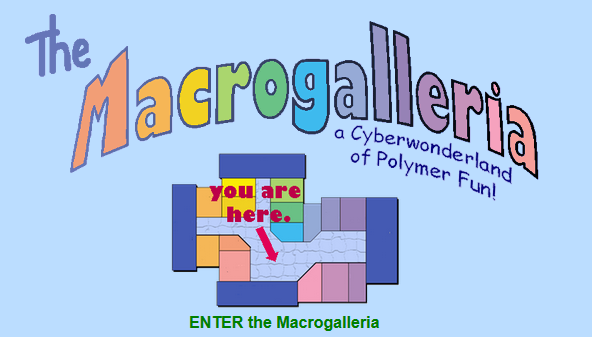
I've been active over the last few months fixing problems and updating lots of areas of the Macrogalleria that needed it. Strange all the things we missed or that have gotten somewhat dated. If you find any mistakes or pages that need fixing, just let me know (same email as above).
And just for kids
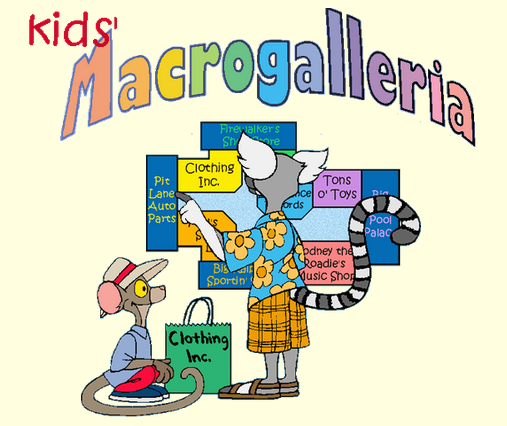
One area I've made lots of updates at is the Kids Macrogalleria, pictured to the right (and you can go there directly by clicking on the picture). There were lots of links that didn't work, and some pages just "went missing" as they like to say on the news. Oh, well, just like Mary's little lamb, they somehow made it back home. Take a look, or better, have a youngster you know (who might find some knowledge of polymers interesting) take that look. Find any problems, email me and I'll try to fix them. Any suggestions for additional subjects or ways to make that level of content better for kids, great! Love to hear about it. On to the next subject...
Virtual travel sections
Which is "Polymer Expeditions!" And sure, we only have two so far, but they're great ones, and we'll get to some more "real soon now..."
The largest and most detailed is the Rubber Expedition, which you can take a quick look at
by clicking on the image below but don't get lost there: Come back! Come Back!
(hint: X marks the spot):


I've fixed some mistakes here but for the most part, everything is as it was, so great! Just to remind you, or let you know if you didn't, this expedition was one of the most fruitful and rewarding collaborations of the PSLC. We worked with the Chemical Heritage Foundation in Philadelphia, sending some of our contributors up to their place to develop most of the material.
One reason for doing this was the large collection of historical documents they possessed, such as the comic book illustrations that are seen throughout the pages of this expedition. Material there covers historical facts relevant to how rubber was first discovered, and especially, how World War II led to the development of synthetic rubber (in all it's glory). Turns out, the Germans had all the natural rubber, and we would have probably lost the war without the herculean efforts of US polymer scientists in figuring out how to make synthetic elastomers- you know, for tires, hoses, fan belts, waterproof boots and raincoats... lots of things that were crucial to winning that horrendous conflict.
Sad to say, but so many of our technological advances happen because of war, mainly because that's when politicians realize they really should kick in some big bucks to make things happen before the enemy comes breathing down our necks (odd image, that).
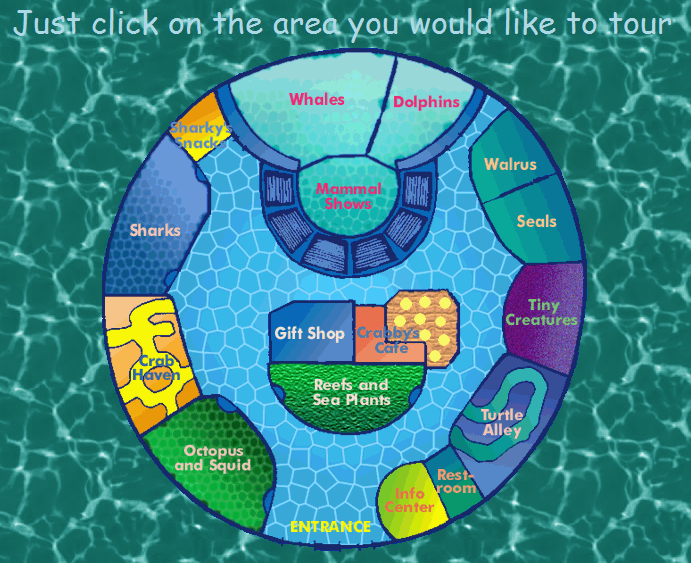
On the other hand, the "Polyquarium" Expedition (picture on the right) needed major work.
This segment of the PSLC is devoted mainly to polymers obtained from animals and plants living
(and dying) in the oceans of the world. There's also lots of information about those
creatures plus interesting facts about how they behave and flourish.
Sadly, some of these (like coral reefs such as the Great Barrier Reef near Australia) are threatened by changes in the environment. Some of those changes may be part of the natural cycle of the planet but there's no question that man is responsible for some as well. Even more sad is the fact that we may not be able to reverse those changes and bring good health back to our oceans.
On to the really new stuff!
Monomer and polymer modelsNow on to some of the exciting new or heavily revised parts of the PSLC! First is the growing collection of 3D chemical models of monomers and polymers. This is something that took major rewriting of the pages plus regenerating of the actual models. Most of the 3D models that were part of the original Macrogalleria were pdb files (stands for "protein database, if that helps). The problem was that the Chime viewer used to look at and manipulate the models in virtual 3D space was shut down by its owner.
A new viewer called jmol was developed by selfless individuals whose names I don't even know but thanks for all your hard work! This new viewer only worked with mol files, so all the molecules had to be redrawn in an older version of Chemdraw, then optimized in Chem3D and saved in the right format. Whew! Took a while for me to figure out all this and get started- huge energy of activation- but once I got the kinks worked out, it was pure fun!
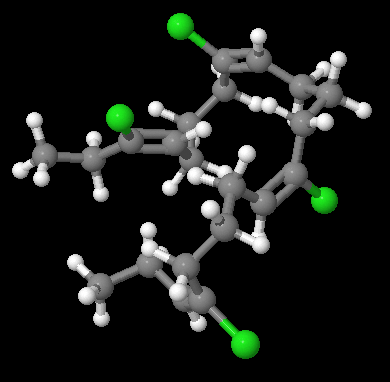
So now there are dozens and dozens each of monomers and polymers for you to pop up in your browser and look at. Even more fun, you can zoom in or out, rotate the model any way you like, and even change from stick-and-ball to other display formats such as van der Waals radii, if that tickles your fancey. Try it, you'll like it! Just click on the image above to get started, and 10 extra points if you can name that polymer!
Polymer of the Month
Now for what I think is the most exciting addition to the PSLC: the Polymer of the Month Pages! Oh, I see you scratching your head and asking yourself, "Say, what?" but bear with me. Each Polymer of the Month describes some weird, unusual and often instructive example of a polymer or polymer-containing material.
The name isn't strictly accurate as you'll find. For example, the one on nylon 6-clay nanocomposites (clip below) isn't strictly just a polymer but a composite. Oh, well, as Ralph Waldo Emerson put it, "A foolish consistency is the hobgoblin of little minds."
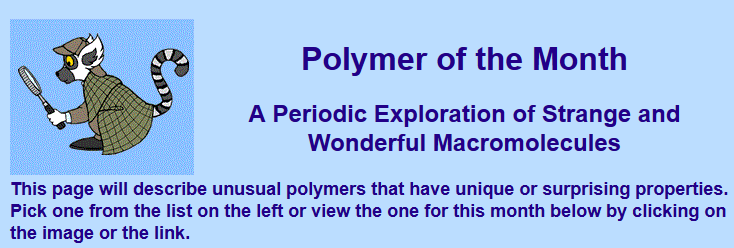

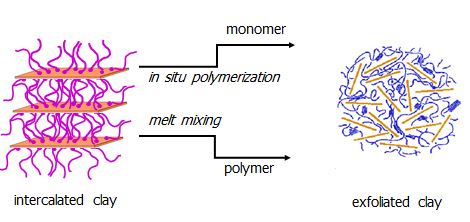
Other pages for this feature will include the unusual effect pendent adamantane groups have on polymer Tg's; the unexpected radical polymerization of allylammonium salts; metathesis ring-opening polymerizations; hydrophilic-hydrophobic polymers used in contact lenses; plus other topics ranging from some involving strange polymer structures and syntheses to unusual properties and applications. Oh, and check out the first entry on poly(4-methyl-1-pentene), a polymer with a number of unusual properties for a simple hydrocarbon.
Suggestions for other unusual, wonderful, illuminating and perhaps even useful polymers to include here would be most welcome. The main focus will be on what's fundamentally different or unusual but has potential for wider use.
So Now What?
Great question, glad you asked. Developments in polymer understanding and application continue unabated. Applications in medicine, for example, range from the molecular targeting of cancer cells using polymeric carriers to the modification and replacement of diseased internal organs. Intra-ocular lenses to replace cataracts, artificial skin to heal large area burns, complex mixtures of chemicals and polymers to promote bone and tendon regeneration are just a few of the applications of polymers that make life better for humans. And the applications extend throughout the animal kingdom, with many developments applied to our co-inhabitants of the planet as well as to humans.If we look at the web traffic to the PSLC and other free education sites, it's clear that the need for such sites is growing. Textbook prices continue to increase, tuition is growing at an accelerating rate, and both while the need for higher education in particular, and broad education in general expand. More and more members of the working population need continuing education to keep up with developments and job requirements, yet funding for such efforts has not expanded at a comparable rate. We (meaning me) need your help, if you're willing.
What I'd like from the chemistry community, especially those with interest or expertise in polymers, are topics for the following.
- Unusual syntheses, properties, structures or applications of polymers for the Polymer of the Month section
- Polymers and monomers crying out for 3D molecular structures- I can do these fairly quickly so send in any that you think others might like to see in all their molecular splendor.
- Corrections anywhere in the various components of the pslc.ws site. I'm working on these as I have time but anything you find that is of paramount importance, let me know.
- Macrogalleria components including new stores of broad interest, polymers that should be included in level 2, synthetic reactions for level 3 and anything for higher levels. I will get to more additions for analysis and processing "sometime real soon."
- Shockwave/Director animation conversions: we have tons of "movies" of reaction mechanisms that are no longer visible. Anyone know a way to convert these to animated gifs, for example? Or some other now-supported format? No time to re-do all those myself (wouldn't know how to even start doing that) but I think they added a lot to the visual learning experience.
- New material for the Paul Lemur and Kids Macrogalleria sections. These can provide excellent supplements for K-12 STEM education. While I'm not able to draw new illustrations like those already there, I can certainly re-purpose those we have for new topics.
- Demos and experiments that are, on the one hand, simple and easy to do with every-day household chemicals and materials, and on the other hand, experiments that can be done in science labs or as demos for STEM recruiting and enhancement.
Well, there you have it for now- recent accomplishments and a plaintive plea for help. I'll keep working on this
as long as I'm able and can afford the upkeep, but hey, all things come to an end. Let's hope that's a long time
coming...
LJM

|
Return to Macrogalleria Directory |

|
Return to the PSLC Directory |